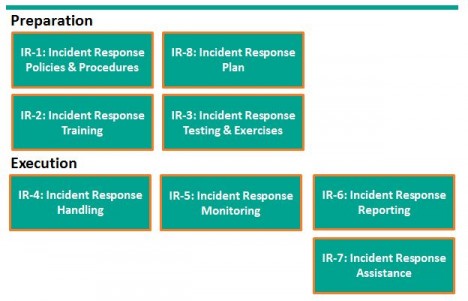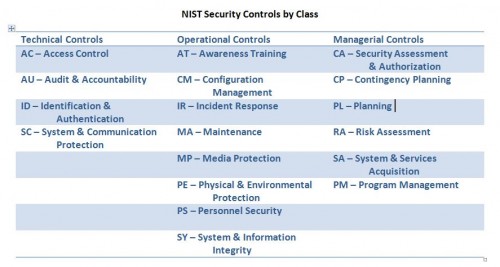Coordinated Response
Services and tools for incident response management
What Does NIST Say About Incident Response?
The National Institute of Standards and Technology (NIST) produced a list of Security Controls for Federal Information Systems. Incident Response is one of the controls.
In Special Publication 800-53, revision 3 NIST included Incident Response as 1 of 18 families of security controls. For the complete list see the end of this item. Much of the material is useful beyond the Federal government.
First, NIST provides a useful framework for considering Incident Response (IR). Please don’t let the control numbers confuse things. I started with preparation, but NIST considers IR Planning as IR-8.
Incident Response preparation starts with Policies and Procedures and the preparation of an incident response plan. With the plan in hand, train users how to recognize and report incidents, train the response team how to organize and react. For some incidents, actually testing the plan with field exercises may be needed.
Incident response execution includes handling, monitoring, reporting, and possibly additional assistance from specialists. NIST suggests each organization consider these controls and determine when or whether they apply.
In SP800-53, Revision 4 Draft, two additional controls were identified: IR-9 Information Spoilage Response and IR-10 Integrated Information Security Cell. The first addresses the additional needs for damaged or leaked information. The latter describes the organization of a specialized element of the Incident Response Team.
While the Incident Response Plan is just one of 8 controls, it touches all the other controls. NIST declares a good Incident Response Plan:
- Provides road map for implementing incident response capability.
- Describes the structure and organization of the incident response capability.
- Provides a high-level approach for how the incident response capability that fits into the overall organization.
- Meets the unique requirements of the organization, which relate to mission, size, structure, and functions.
- Identifies reportable incidents.
- Provides metrics for measuring the incident response capability within the organization.
- Defines the resources and management support needed to effectively maintain and mature an incident response capability.
- Is reviewed and approved at an appropriate level.
I heartily agree with NIST’s declaration.
NIST Security Controls
Here is the complete list of security control families identified in SP 800-53 and organized by the three control classes: Technical, Operational, and Managerial.
New York Times Hacked Again
The New York Times incident response and incident handling provides examples of best practices, as well as, lessons learned.
According to the New York Times, Hackers in China Attacked the Times for Four Months. The Times Incident Response Plan provides examples of best practices as well as lessons learned.
|
|
And the most important best practice is to make security improvements based on the postmortem and lessons learned
In the case of the New York Times, the hackers were able to crack the password for every Times employee. Then the hackers used the passwords to gain access to the personal computers of 53 employees. The attack was discovered on October 25. The investigation placed the initial compromise on or around September 13 or 6 weeks earlier.
First, the Times engaged their Internet Service Provider (ISP), AT&T, to watch for unusual activity as part of AT&T’s intrusion detection protocol. The Times received an alert from AT&T that coincided with the publication of a story on the Chinese Prime Minister’s family wealth.
The New York Times briefed the Federal Bureau of Investigation (FBI). The FBI has jurisdiction over cybercrimes in the United States.
At the start of week 9, when the response team, even with AT&T assistance, was unable to eliminate the malicious code, the Times engaged Mandiant, a firm specializing in cybersecurity breaches. This is both a lesson learned and a best practice. Expect to need additional help when a significant incident occurs, but it’s best to engage the specialists when the response plan is first developed.
The response team identified 45 pieces of malware that provided the intruders with an extensive tool set to extract information. Virus protection only identified 1 piece. This is an important lesson. Advanced or enhanced malware may be difficult to detect. Defense in depth requires added security controls. In this case, monitoring provided the alert.
At this point, the response team “allowed hackers to spin a digital web for four months to identify every digital back door the hackers used”. This allowed the Times to (1) fully eradicate the intruders, (2) determine the extent of the intrusion and data extraction, and (3) build improved defenses for the future. Again, this is a best practice – investigation precedes eradication.
I found the work habits of the hackers particularly interesting. They worked a standard day starting at 8 A.M. Beijing time. Occasionally they worked as late as mid-night including November 6, election night.
A Focus on Incident Response
Coordinated Response is an incident response planning and consulting firm. We help you create an incident response plan, improve upon it, automate it, and manage it.
My focus, my interest, my expertise are in the area of incident response planning and management. Seasoned in business process management & automation, I have helped numerous organizations build business response management solutions. Working with my key advisers – Jim Bothe and John Walsh (see About Us – Leadership) – I began focusing on cybersecurity incident response management.
Where does response management fall in the realm of cybersecurity?
Most people asked about cybersecurity tools mention antivirus software or firewalls or intrusion detection systems. These important tools help to protect systems and information. But, if these tools fail, if an incident occurs, an organized, coordinated response to the incident is needed.
Other people think about the effort to prepare the security plan and architecture. Preparation starts with a risk assessment, includes the security architecture, but should include an incident response plan. To respond to an incident without a well thought out, well tested, well practiced plan increases the risk, the cost, and the overall impact of the incident.
Some organizations might consider any activity performed by the Computer Security Incident Response Team or CSIRT as incident response, but many CSIRT activities are pro-active. The CSIRT may participate in preparation and protection as part of incident management, not just the narrower incident response. In addition, legal, human resources, security may also participate as extended team members of the CSIRT.
The diagram above is based on one in the publication Defining Incident Management Processes for CSIRTs: A Work in Progress, Carnegie Mellon University / Software Engineering Institute, May, 2004. The publication, Technical Report CMU/SEI-2004-TR-015, is available at http://www.sei.cmu.edu/library/abstracts/reports/04tr015.cfm. The authors provide both insight and useful guidance. Be not fooled by its publication date or the tag line “a work in progress”.




